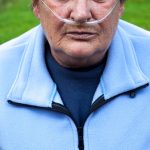 A genetic link has been found between COPD and smoking behavior which can contribute to lung disease. Chronic obstructive pulmonary disease (COPD) is the third leading cause of death worldwide. As a progressive lung disease, breathing becomes more and more difficult over time.
A genetic link has been found between COPD and smoking behavior which can contribute to lung disease. Chronic obstructive pulmonary disease (COPD) is the third leading cause of death worldwide. As a progressive lung disease, breathing becomes more and more difficult over time.
There are different types of COPD including chronic bronchitis and emphysema. Common causes of COPD are smoking, exposure to industrial pollutants, genetics and infection.
Advertisement
Recent findings uncovered a link between COPD and smoking behavior. Shared lung deficiencies were seen in both smokers and nonsmokers, which means that COPD can still be a threat to those who do not smoke if they have a particular gene.
Genetic link for COPD and smoking behavior found
 The study examined the lung function of 152,030 Caucasians of European ancestry, both smokers and non-smokers. They all had a variety of lung function from poor to excellent based on their forced expiratory volume (FEV). With this information researchers aimed to determine if there were any shared links between the individuals. The team also used a new genotyping array, which allowed them to measure over 800,000 gene variations.
The study examined the lung function of 152,030 Caucasians of European ancestry, both smokers and non-smokers. They all had a variety of lung function from poor to excellent based on their forced expiratory volume (FEV). With this information researchers aimed to determine if there were any shared links between the individuals. The team also used a new genotyping array, which allowed them to measure over 800,000 gene variations.
The team uncovered six different gene variants associated with COPD and lung health. These variants were also seen in nonsmokers with COPD. Five gene variants were found in heavy smokers, which researchers believe can be helpful in preventing smoking-related lung disease like COPD.
The authors wrote, “These findings, taken together with previous findings, will help define pathways underlying predisposition to development of COPD and smoking behaviors. A full understanding of the biological mechanisms underlying these genetic associations will improve our understanding of the pathophysiology of COPD and smoking behavior, and potentially give rise to novel therapeutic strategies for the management of airway disease and prevention of nicotine addiction.”
The researchers are hopeful their findings can better help prevent COPD and help people quit smoking.
The smoking and COPD connection
The Centers for Disease Control and Prevention (CDC) says that smoking is involved in 90 percent of COPD cases. In chronic bronchitis, the tubes which carry air to and from the lungs are constantly inflamed and irritated. When a person smokes the many chemicals from the cigarette become released and line the airways and lungs. The lungs are therefore always irritated and cannot function properly.
In emphysema the bronchial tubes become damaged which results in labored breathing. Cigarette smoking contributes to the death of cells and continues to break down the proteins responsible for elasticity. Some studies show that cigarette smoking can contribute to an autoimmune response, where the immune system begins to attack the alveoli tissues.
How does COPD affects your lungs?
 The lungs are a large component of our respiratory system. They work with the heart to get our blood oxygenated and keep us moving. Each lung has a bronchial tree which is responsible for moving around the air. Our lungs also contain grape-like clusters called alveoli and blood cells. All parts of the lungs work together to oxygenate blood, ensure breathing and expel toxins.
The lungs are a large component of our respiratory system. They work with the heart to get our blood oxygenated and keep us moving. Each lung has a bronchial tree which is responsible for moving around the air. Our lungs also contain grape-like clusters called alveoli and blood cells. All parts of the lungs work together to oxygenate blood, ensure breathing and expel toxins.
COPD affects breathing by reducing the air sacs and airway elasticity, destroying the walls of the air sacs, thickening the walls of the air sacs and clogging the lungs with mucus. When these changes occur, air flow becomes more difficult and limited in and out of your lungs. Because your body requires oxygen it can be difficult to perform daily tasks with COPD.
Other causes of COPD
Aside from smoking cigarettes, there are other causes of COPD which include:
- Fumes and dust: From outside pollution, workplace environments, poorly ventilated areas
- Asthma: A previous diagnosis of asthma can already weaken the lungs, putting you at higher risk for COPD
- Age: COPD occurs more in middle-aged people and older
- Secondhand smoke: Secondhand smoke is still as harmful as firsthand
- Genetics
Preventing COPD
You don’t have to experience or develop COPD just because you are getting older; you can still very much prevent COPD from happening to you. Prevention tips of COPD include:
- Stop or never start smoking.
- Avoid being around those who smoke.
- Ensure fireplaces or wood burning stoves are well ventilated.
- Stay inside on days with high pollution – check smog advisories and plan ahead.
- Don’t allow people to smoke in your home.
- Change air filters in your home and car.
- If you work in a place with pollutants, ensure you are wearing proper equipment and ensure the building is properly ventilated.
Breathing exercises to cope with COPD
 Although COPD affects breathing, breathing exercises can actually improve it. Breathing exercises help you better manage your breathing which can make completing daily tasks easier. Here are some breathing exercises you can try in order to improve your COPD.
Although COPD affects breathing, breathing exercises can actually improve it. Breathing exercises help you better manage your breathing which can make completing daily tasks easier. Here are some breathing exercises you can try in order to improve your COPD.
Pursed lip breathing: Studies have shown breathing with pursed lips can reduce the effort it takes to breathe. To complete the technique inhale for counts of two through the nose. Purse your lips and exhale slowly.
Coordinated breathing: If you’re exercising, your breathing can become shorter and lead to anxiety. If participating in exercise, inhale through your nose before the exercise begins. Once again purse your lips and exhale when you begin to exert yourself. For example, inhale and exhale when you lift a weight up and down.
Deep breathing: When air is trapped in the lungs it can create shortness of breath. For deep breathing inhale all the air you can through your nose, then hold it for five seconds. Release all the air until you feel “empty.”
Huff cough: This technique can help expel and break-up mucus. Take in a deep breath and expel it by huffing the air out. You should feel like you’re making a “ha” sound.
Diaphragmatic breathing: The diaphragm is another important part of breathing. While lying on your back place one hand on your chest and the other on your stomach. Take in a breath and feel your stomach rise. Breathe out slowly while applying pressure to push down and expel the air.
COPD may make breathing harder, but with these prevention tips and breathing exercises in mind you can still carry out your life whilst living with COPD.
Related Reading:
COPD knowledge lacking: National study
The COPD in America survey, conducted online during April 2015, involved 1,009 COPD patients currently residing in the U.S. or U.S. citizens living abroad. According to the study, many patients are completely clueless or only partially aware about risk factors and diagnosis. Continue reading…
Advertisement
Trouble breathing? Persistent cough or frequent chest infections? This could be chronic obstructive pulmonary disease (COPD) – the name for a collection of lung diseases including chronic bronchitis, emphysema and chronic obstructive airways disease. Continue reading…
Sources:
http://www.medicalnewstoday.com/articles
http://www.healthline.com/health/copd/facts-statistics-infographic
http://www.everydayhealth.com/copd/causes
http://www.healthline.com/health/copd
//www.belmarrahealth.com/common-causes-of-chronic-obstructive-pulmonary-disease-copd
http://www.everydayhealth.com/copd/treatment
http://www.healthline.com/health/copd/alternative-treatments
http://www.healthline.com/health/copd/breathing-exercises
